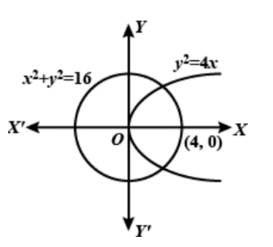
Find the number of points with integral coordinates that lie in the interior of the region common to circle $${x^2} + {y^2} = 16$$ and the parabola ${y^2} = 4x.$
A.8
B.10
C.16
D.None of these
Answer
511.5k+ views
Hint: We need to imagine the graphs of circle and parabola and the intersection of those two figures in a graph.
Let $\left( {\alpha ,\beta } \right)$ be the point with integral coordinates and lying in the interior of the region common to the circle ${x^2} + {y^2} = 16$ and the parabola ${y^2} = 4x.$
Then ${\alpha ^2} + {\beta ^2} - 16 < 0$ and ${\beta ^2} - 4\alpha < 0$

It is clear from the figure that $0 < \alpha < 4$ .
$ \Rightarrow \alpha = 1,2,3$ $\left[ {\because \alpha \in Z} \right]$
When $\alpha = 1$
${\beta ^2} < 4\alpha $
$ \Rightarrow {\beta ^2} < 4$
$ \Rightarrow \beta = 0,1$
So the points are (1, 0) and (1, 1).
When $\alpha = 2$
${\beta ^2} < 4\alpha $
$ \Rightarrow {\beta ^2} < 8$
$ \Rightarrow \beta = 0,1,2$
So the points are (2, 0), (2, 1) and (2, 2).
When $\alpha = 3$
${\beta ^2} < 4\alpha $
$ \Rightarrow {\beta ^2} < 12$
$ \Rightarrow \beta = 0,1,2,3$
So the points are (3, 0), (3, 1), (3, 2) and (3, 3)
Out of these four points (3, 3) does not satisfy ${\alpha ^2} + {\beta ^2} - 16 < 0$.
Thus, the points lying in the region are (1, 0), (1, 1), (2, 0), (2, 1), (2, 2), (3, 0), (3, 1) and (3, 2).
Note:
It is always better to start with the graph of given equations for these kinds of problems for better visualization.
Let $\left( {\alpha ,\beta } \right)$ be the point with integral coordinates and lying in the interior of the region common to the circle ${x^2} + {y^2} = 16$ and the parabola ${y^2} = 4x.$
Then ${\alpha ^2} + {\beta ^2} - 16 < 0$ and ${\beta ^2} - 4\alpha < 0$

It is clear from the figure that $0 < \alpha < 4$ .
$ \Rightarrow \alpha = 1,2,3$ $\left[ {\because \alpha \in Z} \right]$
When $\alpha = 1$
${\beta ^2} < 4\alpha $
$ \Rightarrow {\beta ^2} < 4$
$ \Rightarrow \beta = 0,1$
So the points are (1, 0) and (1, 1).
When $\alpha = 2$
${\beta ^2} < 4\alpha $
$ \Rightarrow {\beta ^2} < 8$
$ \Rightarrow \beta = 0,1,2$
So the points are (2, 0), (2, 1) and (2, 2).
When $\alpha = 3$
${\beta ^2} < 4\alpha $
$ \Rightarrow {\beta ^2} < 12$
$ \Rightarrow \beta = 0,1,2,3$
So the points are (3, 0), (3, 1), (3, 2) and (3, 3)
Out of these four points (3, 3) does not satisfy ${\alpha ^2} + {\beta ^2} - 16 < 0$.
Thus, the points lying in the region are (1, 0), (1, 1), (2, 0), (2, 1), (2, 2), (3, 0), (3, 1) and (3, 2).
Note:
It is always better to start with the graph of given equations for these kinds of problems for better visualization.
Recently Updated Pages
Glucose when reduced with HI and red Phosphorus gives class 11 chemistry CBSE

The highest possible oxidation states of Uranium and class 11 chemistry CBSE

Find the value of x if the mode of the following data class 11 maths CBSE

Which of the following can be used in the Friedel Crafts class 11 chemistry CBSE

A sphere of mass 40 kg is attracted by a second sphere class 11 physics CBSE

Statement I Reactivity of aluminium decreases when class 11 chemistry CBSE

Trending doubts
10 examples of friction in our daily life

The correct order of melting point of 14th group elements class 11 chemistry CBSE

Difference Between Prokaryotic Cells and Eukaryotic Cells

One Metric ton is equal to kg A 10000 B 1000 C 100 class 11 physics CBSE

State and prove Bernoullis theorem class 11 physics CBSE

What organs are located on the left side of your body class 11 biology CBSE




